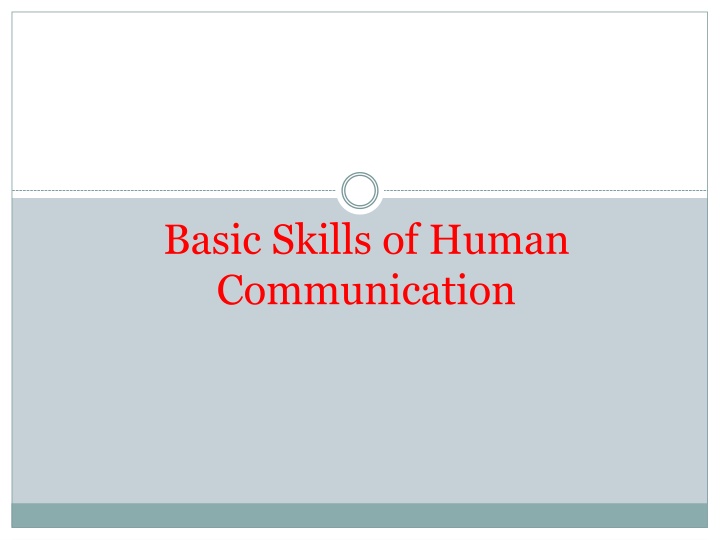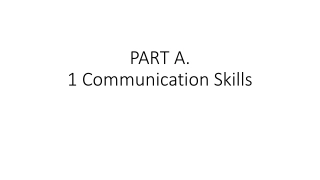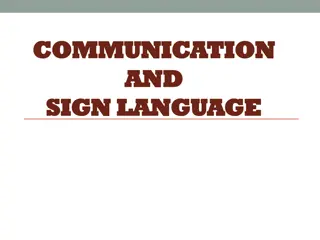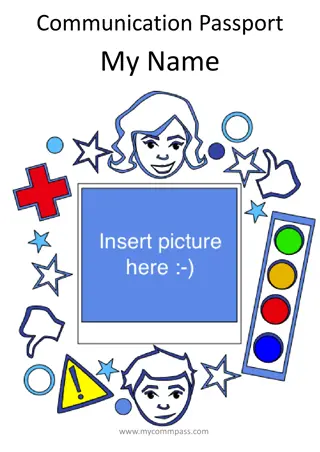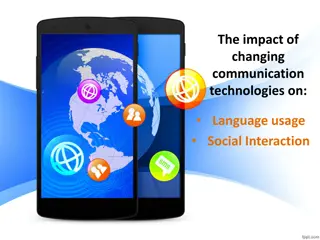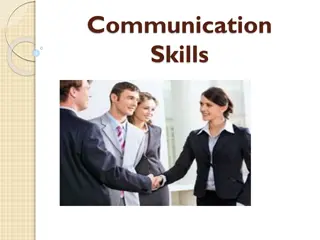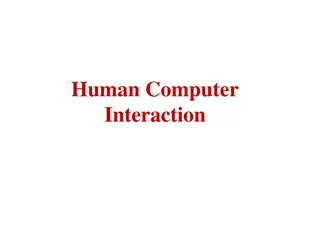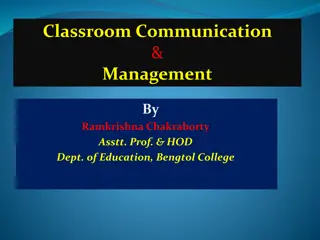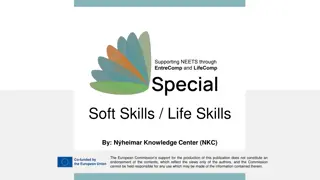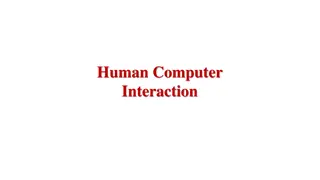Enhancing Communication Skills for Effective Interaction
Communication skills are crucial for transmitting information effectively. This article delves into the basics of human communication, emphasizing the importance of fundamental skills in health education and promotion. It explores different communication approaches, barriers, and strategies, highlighting the significance of non-verbal communication. The content also debunks common myths about listening and provides insight into the dynamic nature of the communication process.
Download Presentation

Please find below an Image/Link to download the presentation.
The content on the website is provided AS IS for your information and personal use only. It may not be sold, licensed, or shared on other websites without obtaining consent from the author.If you encounter any issues during the download, it is possible that the publisher has removed the file from their server.
You are allowed to download the files provided on this website for personal or commercial use, subject to the condition that they are used lawfully. All files are the property of their respective owners.
The content on the website is provided AS IS for your information and personal use only. It may not be sold, licensed, or shared on other websites without obtaining consent from the author.
E N D
Presentation Transcript
Basic Skills of Human Communication
CHS 382 Objectives: Recognize the basic knowledge regarding the fundamentals of health education/health promotion Identify different approaches and strategies of health promotion. Illustrate communication skills utilized in various health settings. Relate basic communication skills to health education/health promotion profession
Outline: The concept of communication Basic communication skills profile Hearing Vs Listening Overview of the communication process Aspects of communication Barriers in communication Essentials of successful communication NVC
How good are your communication skills? https://www.mindtools.com/pages/article/newCS_99.htm
What does communication mean? Communication is the art of transmitting information, ideas and attitudes from one person to another. Communication is the process of meaningful interaction among human beings
Communication - Meaning Communication is a dynamic process Through this process we convey a thought or feeling to someone else. How it is received depends on a set of events, stimuli, that person is exposed to. how you say what you say plays an important role in communication.
Communication is a Series of Experiences Hearing Smell Seeing Touch Taste
Basic Communication Skills Profile ________________________________________________ Communication Order Learned Extent Used Extent Trained ____________________________________________ Listening First First Fourth Speaking Second Second Third Reading Third Third Second Writing Fourth Fourth First
Myths about Listening Listening and hearing are the same Good readers are good listeners Smarter people are better listeners Listening improves with age Listening skills are difficult to learn
Hearing Vs. Listening Hearing Physical process, natural, passive Listening Physical as well as mental process, active, learned process, a skill Listening is hard !! You must choose to participate in the process of listening.
Active Listening The process of hearing spoken words and noting nonverbal behavior. Active listening takes energy and concentration.
VALUE OF LISTENING Listening to others is an elegant art. Good listening reflects good manners. Listening carefully to the instructions of superiors improve competence and performance. The result of poor listening skill could be disastrous in business, employment and social relations. Good listening skill can improve social relations and conversation.
Stages of the Listening Process: Hearing Focusing on the message Comprehending and interpreting Analyzing and Evaluating Responding Remembering
Barriers to Active Listening: Environmental barriers Physiological barriers Psychological barriers Selective listening Negative listening attitudes Personal reactions Poor motivation
Improving Listening Skills By not being Preoccupied Being Open Minded & Non Defensive Minimizing Interruptions Effective Listening is: Hearing, interpreting when necessary, understanding the message and relating to it. By Asking Questions
The idea is encoded. Perception Self-concept Family Culture Skills Feelings Attitudes Values SENDER Individuals ENCODE ideas according to their own unique perceptions
The encoded idea is sent in a message SENDER Self-concept Family Culture Skills Feelings Attitudes Values RECEIVER Self-concept Family Culture Skills Feelings Attitudes Values MESSAGE Individuals DECODE ideas according to their own unique perceptions
The receiver responds with feedback SENDER Self-concept Family Culture Skills Feelings Attitudes Values RECEIVER Self-concept Family Culture Skills Feelings Attitudes Values MESSAGE FEEDBACK Feedback helps to ensure that the message Feedback helps to ensure that the message received has been decoded correctly received has been decoded correctly
Channel - the means of conveying the message CHANNEL SENDER Self-concept Family Culture Skills Feelings Attitudes Values RECEIVER Self-concept Family Culture Skills Feelings Attitudes Values MESSAGE FEEDBACK CONTEXT Context - the situation, environment or circumstances of the communication
Interference CHANNEL SENDER Self-concept Family Culture Skills Feelings Attitudes Values RECEIVER Self-concept Family Culture Skills Feelings Attitudes Values MESSAGE INTERFERENCE FEEDBACK CONTEXT Interference changes or distorts the message
The communication process is continuous CHANNEL SENDER Self-concept Family Culture Skills Feelings Attitudes Values RECEIVER Self-concept Family Culture Skills Feelings Attitudes Values MESSAGE MESSAGE MESSAGE INTERFERENCE FEEDBACK FEEDBACK FEEDBACK CONTEXT
To sum up, there are essential aspects of the communication process as the following: . Sender - the one who conveys the message to another person. Message - the thought, idea, or emotion conveyed. Channel - how the message is sent.
Aspects of Communication (Cont.) Receiver - physiological/ psychological components. Feedback - the receiver s response to the sender. Influences - Culture, education, emotions and other factors involved.
Developing Effective Feedback Skills: Focus on the specific topic Keep feedback impersonal Keep feedback goal oriented Make feedback well timed Ensure understanding Direct feedback toward a subject that is controllable by the recipient
Barriers in Communication (that have to do with the SENDER) Unwillingness to say things differently Unwillingness to relate to others differently Unwillingness to learn new approaches Lack of self-confidence Lack of enthusiasm Prejudice
Barriers in Communication (that have to do with the SENDER) Disagreement between verbal and non-verbal messages Negative self image Lack of feedback Lack of motivation and training Language and vocabulary level Lack of self awareness
Barriers in Communication (that have to do with the RECEVER) Selective Perception Unwillingness to change Lack of interest in the topic/subject Prejudice & belief system Personal value system
General Barriers in Communication Environment The venue The effect of noise Temperature in the room Mood OtherPeople Status, Education, competition Time
General Barriers in Communication Inappropriate medium Assumptions/Misconception Emotions Language differences Poor listening skills Distractions transmitter
ESSENTIALS OF COMMUNICATION Dos Always think ahead about what you are going to say. Use simple words and phrases that are understood by every body. Increase your knowledge on all subjects you are required to speak. Speak clearly and audibly. Check twice with the listener whether you have been understood accurately or not
ESSENTIALS OF COMMUNICATION Dos In case of an interruption, always do a little recap of what has been already said. Always pay undivided attention to the speaker while listening. While listening, always make notes of important points. Always ask for clarification if you have failed to grasp other s point of view. Repeat what the speaker has said to check whether you have understood accurately.
ESSENTIALS OF COMMUNICATION DON Ts Do not instantly react and mutter something in anger. Do not use technical terms & terminologies not understood by majority of people. Do not speak too fast or too slow. Do not speak in inaudible surroundings, as you won t be heard.
ESSENTIALS OF COMMUNICATION DON Ts Do not assume that every body understands you. While listening do not glance here and there as it might distract the speaker. Do not interrupt the speaker. Do not jump to the conclusion that you have understood every thing.
Non-Verbal Communication HTTPS://WWW.YOUTUBE.COM/WATCH?V=CS AYYPXBCZG
Definition of NVC All communication other than that involving words and language Bodily communication, other than words and language
Categorisation of NVC Paralanguage Paralanguage consists of the non-verbal elements that accompany speech. It includes: The way we speak (also known as prosodic features) Volume, pitch, intonation, speed of delivery, articulation, rhythm The sounds we make other than language Laughter, crying, yawning, sighing, screeching, coughing Filled pauses such as Mmmm , Ahhh , Ummm Unfilled pauses
Categorisation of NVC Physical Appearance Clothing, hairstyle, make-up, jewellery, tattoos, piercings, glasses, accessories such as bags You only have to think of the huge industries associated with the above examples to recognise the cultural significance of physical appearance
Categorisation of NVC Physical Appearance Many societies had (and some still do have) highly regulated codes of dress, often linked to rank and status It is the body s capacity to communicate aspects of an individual s identity which makes us so aware of our physical appearance
Categorisation of NVC Physical Appearance Self expression in contemporary culture is also limited by requirements to wear uniforms or to observe dress codes Not necessarily restricted to schools and public services Many corporations and organisations expect employees to communicate a corporate rather than an individual identity
Further Categories of NVC - Activity Body movement (kinesics) Closeness (proxemics) Touching (haptics) Eye movement Smells
Body Movement Kinesics: Gesture, facial expression, posture, head nodding, orientation Emblems gestures with specific cultural meanings attached Illustrators reinforce words of speakers
Closeness Proxemics: Study of how we use space and distance Ideas of personal space , invasion of personal space and comfort zones Use of objects as markers to indicate ownership of space
Touching - Haptics Physical contact such as holding, stroking, shaking hands, guiding Linked to proxemics Touch is very important in our early development Many rules and taboos regulating physical contact
Eye Movement: Eye movement, length and direction of gaze, changes in pupil size We are hypersensitive to information imparted by eyes Can be argued eyes reveal the truthfulness of what is being said
Smell Smell: Humans do not have a particularly well-developed sense of smell compared with other species Perfumes and deodorants send powerful messages. A rapidly growing industry has developed around the use of smells
Complex Messages: Rare for these non-verbal codes to operate in isolation from one another, or separately from language We create and perceive messages using signs from a range of verbal and non-verbal codes To make this even more complex, these signs and codes to not always pull in the same direction
